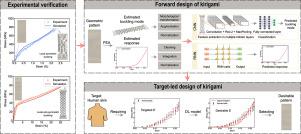当前位置:
X-MOL 学术
›
Int. J. Mech. Sci.
›
论文详情
Our official English website, www.x-mol.net, welcomes your feedback! (Note: you will need to create a separate account there.)
Deep learning of buckling instability in geometrically symmetry-breaking kirigami
International Journal of Mechanical Sciences ( IF 7.1 ) Pub Date : 2024-07-01 , DOI: 10.1016/j.ijmecsci.2024.109331 Yunce Zhang , Yafei Wang , Qiang Tao , Yuanpeng Liu , Changguo Wang
International Journal of Mechanical Sciences ( IF 7.1 ) Pub Date : 2024-07-01 , DOI: 10.1016/j.ijmecsci.2024.109331 Yunce Zhang , Yafei Wang , Qiang Tao , Yuanpeng Liu , Changguo Wang

|
Kirigami, subjected to escalating strain, frequently exhibits pronounced instability, coupled with remarkable flexibility and extraordinary extensibility. This behavior holds significant relevance for domains associated with malleable and reconfigurable surfaces, including stretchable electronics and modifiable functional devices. Nonetheless, conventional design methodologies, anchored in geometric symmetry and governed by minimum energy principles, tend to manifest buckling instabilities restricted to symmetric and anti-symmetric modes. To scrutinize the mechanisms of buckling behavior that disrupt geometric symmetry and comprehend the influence of geometry on programmability during reconfiguration, we propose an innovative strategy for kirigami’s design. This strategy capitalizes on advanced deep learning methodologies, employing convolutional neural networks (CNNs) for categorizing buckling modes and recurrent neural networks (RNNs) for prognosticating constitutive relationships. Our approach furnishes a programmable design solution adept at identifying optimal kirigami patterns, characterized by their superior tensile strength and distinct buckling conformations, thereby fulfilling a diverse array of functional necessities. Our results illustrate that the proposed method displays a high level of precision in distinguishing between buckling modes of geometric symmetry and patterns that deviate from such symmetry. The buckling mode space has been extended and rediscovered, allowing unique modes to have the potential to be adopted into functional devices. Additionally, it demonstrates minimal losses in predicting constitutive relationships. Intriguingly, we discovered that tensile responses are geometry-centric and adjustable. Buckling modes showcase a dependency on geometry, with certain geometric parameters either significantly augmenting the sensitivity of buckling modalities or causing the buckling instability modes to become apathetic and unresponsive. Guided by the principle of target-led pattern parameter design, we proffer prospective tactics for the design of kirigami capable of delivering the desired mechanical performance. Moreover, we explore the feasibility of employing alternative biological materials in these designs.
中文翻译:

几何对称破缺剪纸中屈曲不稳定性的深度学习
剪纸在承受不断升级的压力时,经常表现出明显的不稳定性,同时又具有非凡的灵活性和非凡的可扩展性。这种行为对于与可延展和可重构表面相关的领域具有重要意义,包括可拉伸电子设备和可修改功能设备。尽管如此,以几何对称性为基础并受最小能量原理支配的传统设计方法往往会表现出仅限于对称和反对称模式的屈曲不稳定性。为了仔细研究破坏几何对称性的屈曲行为机制并理解几何结构对重构过程中可编程性的影响,我们提出了一种创新的 kirigami 设计策略。该策略利用先进的深度学习方法,采用卷积神经网络 (CNN) 对屈曲模式进行分类,并采用循环神经网络 (RNN) 来预测本构关系。我们的方法提供了一种可编程设计解决方案,擅长识别最佳剪纸图案,其特点是卓越的拉伸强度和独特的屈曲构造,从而满足各种功能需求。我们的结果表明,所提出的方法在区分几何对称的屈曲模式和偏离这种对称性的模式方面表现出很高的精度。屈曲模式空间已得到扩展和重新发现,使独特的模式有可能被采用到功能器件中。此外,它在预测本构关系方面表现出最小的损失。有趣的是,我们发现拉伸响应以几何形状为中心并且可调节。 屈曲模式表现出对几何形状的依赖性,某些几何参数要么显着增强屈曲模态的灵敏度,要么导致屈曲不稳定模式变得冷漠和无响应。在以目标为主导的图案参数设计原则的指导下,我们为能够提供所需机械性能的剪纸设计提供了前瞻性策略。此外,我们探索了在这些设计中采用替代生物材料的可行性。
更新日期:2024-07-01
中文翻译:

几何对称破缺剪纸中屈曲不稳定性的深度学习
剪纸在承受不断升级的压力时,经常表现出明显的不稳定性,同时又具有非凡的灵活性和非凡的可扩展性。这种行为对于与可延展和可重构表面相关的领域具有重要意义,包括可拉伸电子设备和可修改功能设备。尽管如此,以几何对称性为基础并受最小能量原理支配的传统设计方法往往会表现出仅限于对称和反对称模式的屈曲不稳定性。为了仔细研究破坏几何对称性的屈曲行为机制并理解几何结构对重构过程中可编程性的影响,我们提出了一种创新的 kirigami 设计策略。该策略利用先进的深度学习方法,采用卷积神经网络 (CNN) 对屈曲模式进行分类,并采用循环神经网络 (RNN) 来预测本构关系。我们的方法提供了一种可编程设计解决方案,擅长识别最佳剪纸图案,其特点是卓越的拉伸强度和独特的屈曲构造,从而满足各种功能需求。我们的结果表明,所提出的方法在区分几何对称的屈曲模式和偏离这种对称性的模式方面表现出很高的精度。屈曲模式空间已得到扩展和重新发现,使独特的模式有可能被采用到功能器件中。此外,它在预测本构关系方面表现出最小的损失。有趣的是,我们发现拉伸响应以几何形状为中心并且可调节。 屈曲模式表现出对几何形状的依赖性,某些几何参数要么显着增强屈曲模态的灵敏度,要么导致屈曲不稳定模式变得冷漠和无响应。在以目标为主导的图案参数设计原则的指导下,我们为能够提供所需机械性能的剪纸设计提供了前瞻性策略。此外,我们探索了在这些设计中采用替代生物材料的可行性。












































 京公网安备 11010802027423号
京公网安备 11010802027423号